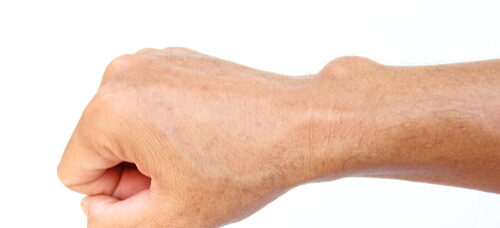
Orthoses for the Management of Upper Extremity Pain
A Narrative Review
Here’s a compelling review of immobilization orthoses that every clinician working with hand conditions should be aware of. I found this article in the International Journal of Pain, not a typical resource that therapists would have access to or review. But the descriptions of the conditions, various orthoses and the studies cited to support their use with patients is informative.
The author describes how musculoskeletal pain in the upper extremities and associated symptoms such as numbness and tingling can reduce range of motion and strength and can negatively impact one’s activities of daily living. Conservative care and the use of immobilizing orthoses help to manage the following painful conditions:
- De Quervain’s Tenosynovitis
- Carpal Tunnel Syndrome
- Osteoarthritis
- Elbow Epicondylitis
- Should dislocation/ Subluxation
1. De Quervain’s Tenosynovitis
De Quervain’s tenosynovitis, or tendinitis of the first dorsal compartment of the extensor tendons, is caused by inflammation surrounding the tendons of the Abductor Pollicis Longus and Extensor Pollicis Brevis muscles. Pain typically occurs with simultaneous ulnar deviation of the wrist and thumb flexion. A long opponens orthosis that immobilizes the wrist and thumb is prescribed to allow for healing of the tendon sheaths inside the first dorsal compartment. Other treatments might include heat, ultrasound, phonophoresis, extracorporeal shock wave therapy, injections and/or medications. A previously mentioned study in our Orfit blog posts (https://www.orfit.com/physical-rehabilitation/blog/de-quervains-syndrome-and-orthotic-management) highlights a hinged orthosis that allows for active wrist flexion and extension but prevents radial and ulnar deviation. The author cites an additional study by Liu et al (2020) that compared long opponens orthoses to short opponens orthoses (orthoses that did not include the wrist) for the treatment of De Quervain’s Tenosynovitis. This study found no difference between the use of the different thumb-based orthoses but suggested that patients with this syndrome use utensils with larger handle diameters. A typical time frame for the orthosis might be 6 weeks or until symptoms are resolved.

Orfit Colors NS – Bright Pink – Hinged Long Opponens Orthosis that allows for active wrist flexion and extension but prevents radial and ulnar deviation
Learn more: De quervains syndrome and orthotic management
2. Carpal Tunnel Syndrome
Carpal tunnel syndrome (CTS) is a condition where the median nerve is compressed in the carpal tunnel at the base of the palm due to overuse of the wrist, edema, trauma or other causes. Pressure inside the carpal tunnel is increased with the wrist in extreme extension and/or flexion. The use of a wrist cock up orthosis positions the wrist so that the pressure inside the carpal tunnel is minimized. This can be from neutral wrist to 10 degrees of extension. The author here suggests a position of 20-30 degrees of extension, but this might cause symptoms as well. The author cites a study by Farahmand et al (2021) comparing the use of a volar based wrist cock-up orthosis to the use of a dorsal lock wrist-hand orthosis in patients with CTS. This latter orthosis included the MCP joints and the PIP joints in slight flexion. After 3 weeks of use, patients reported significant pain reduction with both types of orthoses. The author also recommends a resting hand orthosis or the long thumb opponens orthosis for Carpal Tunnel Syndrome. Both of these orthoses appear to be a bit more restrictive than necessary.

A Dorsal Cock Up Orthosis fabricated from Orfit Eco.
Learn more: Splint in the spotlight: Dorsal Wrist Cock Up Orthosis
Watch video tutorial: Multifit NS dorsal wrist orthosis
3. Osteoarthritis
There are different types of arthritis that can affect the joints of the hand. Osteoarthritis (OA) is typically the result of wear and tear of the cartilage while Rheumatoid Arthritis (RA) is a systemic disease. OA typically affects the carpometacarpal (CMC) joint of the thumb and the proximal interphalangeal (PIP) joints and distal interphalangeal (DIP) joints of the fingers. RA typically causes joint swelling, pain, and joint deformities. Both conditions can respond well to the use of orthoses. Here the author references the Knuckle Bender orthosis which positions the MCP joints in flexion. But he mistakenly states that this orthosis is used for swan neck deformities. However, based on the photo, this orthotic design would have a negative influence on swan neck deformities as it presses downward on the proximal phalanges which might cause the middle phalanges to hyperextend. The author does suggest the use of the silver ring orthoses in the Figure of Eight design which indeed place the PIP joint in flexion and prevent hyperextension of the joint. The author cites a survey by Roux et al (2021) which reported outcome measures for 850 patients after using a silver ring orthosis to prevent swan neck deformities for 3 weeks. Overall, the results of this survey show that patients overwhelmingly had their daily functioning improve with the use of the finger-based orthoses.

Figure of 8″ orthosis for MCP Joint Instability in Orficast 3 cm (1”)
Video tutorial: Anti-Swan Neck orthosis (rolled oval 8)
4. Elbow Epicondylitis
The lateral epicondyle of the elbow is the origin of the supinator muscle and all of the extensor muscles of the wrist and fingers, while the medial epicondyle is the origin of the pronator teres muscle and the wrist and finger flexor muscles. These areas can be sources of pain with overuse of the wrist muscles and /or trauma to the elbow. A forearm band placed over the widest part of the forearm musculature can reduce tension at the origin of the muscles. The band should not be so tight as to restrict blood flow or sensory input. The author also recommends the use of an elbow sleeve with straps placed above and below the elbow joint. A study by Barati et al (2019) compared the use of the lateral forearm band and the elbow sleeve in patients with lateral epicondylitis and found that both types of orthotic management helped to reduce symptoms when compared with a control group and no orthosis.

Making of a tennis elbow tension ring
Watch video tutorial: Epicondylitis ring – Orficast Instructional Movie
Watch video tutorial: Counter Force Strap Orthosis for the treatment of Tennis Elbow or Lateral Epicondylitis
5. Shoulder Dislocation / Subluxation
Lastly, the author describes the condition of shoulder dislocation caused by trauma, stroke or sports activities. This condition is caused by rupture of the labrum and is classified as anterior, posterior or inferior instability of the shoulder. A sling type orthosis can be used to restore the labrum to its anatomical position and reduce the stress on the joint. These orthoses incorporate a strap around the trunk and a cushion placed under the arm to prevent adduction contracture. The orthosis is designed to induce relocation of the humeral head, relieve pain and prevent further damage through traction. A study by Harwig et al (2012) assessed a commercially available orthosis for shoulder dislocation in patients with shoulder subluxation post stroke. The study found the use of the orthosis was effective for controlling symptoms in this population.

Making of a scapulo-humeral shoulder cuff orthosis
Learn more: Splinting guide: Scapulo Humeral Shoulder Cuff Orthosis
Orfit Industries features fabrication videos for all of the above-mentioned orthotic interventions with the exception of the shoulder sling. Please visit the Orfit Academy at www.orfit.com/academy to sign up and watch how to fabricate the long opponens orthosis, the volar and dorsal based wrist orthoses, the anti -swan neck Figure of Eight orthosis and the lateral forearm band.
References
Choo, Y. J. (2022). Orthoses for the Management of Upper Extremity Pain: A Narrative Review. International Journal of Pain, 13(1), 25-35.
![]()

Writer: Debby Schwartz, OTD, OTR/L, CHT
Physical Rehabilitation Product and Educational Specialist at Orfit Industries America.
Debby is a certified hand therapist with over 36 years of clinical experience. She completed her Doctorate of Occupational Therapy at Rocky Mountain University of Health Professions in 2010. She has worked at Orfit Industries America as Product and Educational Specialist since 2007.
Debby is also an adjunct professor at the Occupational Therapy Department of Touro University, School of Health Sciences, and at the Occupational Therapy Department at Yeshiva University, Katz School of Science and Health in NYC. She has written many book chapters in the field of hand therapy and multiple articles for hand therapy journals, including the ASHT Times and the Journal of Hand Therapy. She has published a new textbook on orthotic fabrication together with Dr. Katherine Schofield, entitled “Orthotic Design and Fabrication for the Upper Extremity: A Practical Guide”.
![]()
If you’d like to receive the latest product updates and interesting Orfit news, subscribe to our newsletter:



